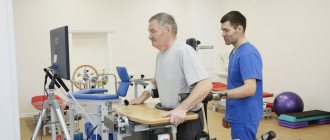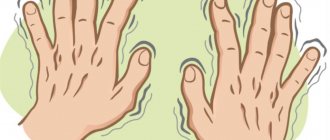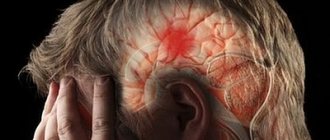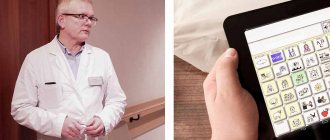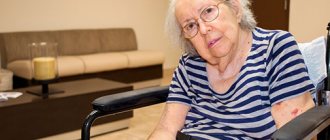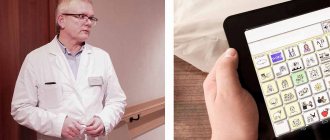24.11.2016
Pinchuk Elena Anatolyevna
Deputy chief physician for medical work, kmn, neurologist, doctor of physical and rehabilitation medicine
Lipovka Nadezhda Sergeevna
Head of the Department of Medical Rehabilitation, Physician of Physical and Rehabilitation Medicine, Neurologist
Sobolev Arkady Igorevich
Doctor of physical and rehabilitation medicine, neurologist
Stroke is a serious nervous disease due to disturbances in the vital functions of the brain. Depending on the location of the lesion, patients may experience different symptoms. There are hemorrhagic stroke (rupture of blood vessels in the cerebral cortex, hemorrhage) and ischemic stroke (the left side of the human brain is affected due to blockage of blood vessels by blood clots or plaques). Doctors name the following causes of stroke as the most likely:
- Diseases of the cardiovascular system;
- Blood composition disorders;
- Some infectious diseases;
- Diabetes;
- Abuse of hormonal and contraceptive drugs;
- Frequent migraines accompanied by aura;
- Osteochondrosis of the cervical spine;
- Bad habits (smoking, alcohol)
Symptoms and signs of left-sided ischemic stroke
Left-sided stroke has general and specific symptoms. General symptoms include severe and sharp headache, vomiting, impaired consciousness, impaired coordination of movements, speech, and vision. The rhythm of breathing may change, and difficulty swallowing may occur. Symptoms may vary depending on the location of the lesion in the brain.
A feature of a stroke that affects the left hemisphere of a person’s brain is complete or partial paralysis of the right side of the body. Sensitivity is impaired and muscle tone changes. In the cortex of the left hemisphere there are areas responsible for speech functions (Wernicke's center and Broca's center). With severe damage to these areas, patients completely lose the ability to speak. In mild cases, they can only speak individual words.
Often, with a left-sided stroke, patients’ ability to think logically disappears and lethargy occurs. If the lesion is located in the temporal lobe of the left hemisphere, then the patient’s emotional state is disturbed. Depression occurs, which, in combination with speech impairment, significantly complicates the correct diagnosis.
Is a numb left hand a trifle or a serious illness?
The problem of “why my left hand goes numb” should not be taken lightly. It is closer to the heart, and tingling with loss of sensitivity can be a harbinger of dangerous diseases.
Trouble after sleep
If you wake up in the morning and find subcutaneous goosebumps on your arm, this is not yet a cause for alarm. Shake your hand, hands, make vigorous rotational movements, massage the skin and muscles. If the unpleasant sensations have disappeared, then nothing terrible has happened. You may have simply laid on your hand at night and pressed on the blood vessels and nerves.
Tissues that have not received sufficient nutrition warn you about this. They also signal about their long-term inactivity. Our body is designed in a very economical way - those organs that are not active are weaned off life support. Try to hold your hand motionless - after a while it will begin to go numb.
Symptoms
Children are fidgety not because of their nature, but because every growing tissue in them is constantly involved. The habit of constantly and rigidly resting your elbow on a table, such as a computer table, can lead to ulnar neuritis. You will know about it if the little finger on your left hand goes numb.
Loss of sensation may also affect the ring finger. The causes of numbness in the left hand may be associated with pathology in the veins and nerves. If numbness is periodically replaced by tingling, this may be a symptom of a stroke, atherosclerosis or heart attack. Everyone probably knows about their danger.
A sign of an impending heart attack may be if you have numbness in your left arm from the elbow to the hand, which occurs while you are awake. In this case, the only recommendation is to contact a doctor as soon as possible, or better yet, call an ambulance. If the left palm goes numb, this indicates problems in the heart. In this case, you should contact a cardiologist.
Stroke
The worst sign of numbness in the left hand is a stroke. If you have a stroke, it requires immediate hospitalization. It is dangerous not only due to partial paralysis, as many people think. Untimely medical attention can lead to bleeding in the brain and or blockage of blood vessels.
Loss of consciousness, followed by stopping breathing and death - this is the sequence of possible outcomes. A stroke claims the life of every third, or even second, person who dies in peaceful conditions. It is also the main cause of disability today.
It should be borne in mind that when the right hemisphere of the brain is damaged, the left part of the body suffers, and when the left hemisphere is damaged, the right part suffers, in particular, the right hand goes numb. There is no point in giving in to premature panic either. Find out if there are other symptoms besides unilateral numbness:
- Sudden visual impairment - deterioration or double vision;
- Difficulty speaking – pronunciation or intelligibility;
- Difficulty understanding the simplest sentences;
- Loss of coordination, balance, dizziness;
- Sudden, intense and unexplained headaches.
If at least two or three signs are detected, you can no longer hesitate. The heart also needs to be checked if the little finger and/or ring finger are numb. This may be a warning of an impending stroke.
Osteochondrosis
The now very common spinal disease known as osteochondrosis is extremely unpleasant. Neglecting treatment at the initial stage is fraught with serious consequences. Curvature of the spine (scoliosis) in one area leads to changes along the entire spinal column. And since the spinal cord is the center for controlling reflexes, the muscular restructuring that occurs along the vertebrae will have a very unfavorable effect on the organs.
Compression of the nerve roots at the exit from the vertebrae by the muscles, or irritation of them by deformed intervertebral discs will result in pain and numbness of the limbs. Almost any clinical form of coronary heart disease responds in one way or another with paresthesia. This problem can also serve as a signal of vascular atherosclerosis. Considering its proximity to the heart, one must remember that a blood clot that breaks away from the wall of a vein in the arm very quickly reaches both the heart and the brain.
Left hand and fingers
If paresthesia covers exclusively the area of the hand, and these sensations are accompanied by painful feelings of varying intensity, most likely you have “carpal tunnel syndrome.” The carpal (or metacarpal) canal is a narrow opening in the area of the tendon ligaments of the wrist through which the main trunk of the median nerve passes.
As a rule, this disease occurs in people whose work is associated with constant overexertion of the hand (pianists, computer work), a process of nerve pinching occurs, accompanied by such negative symptoms. If left untreated, there is a risk of loss of self-care ability, so seek immediate medical attention.
The fingers on the left hand go numb due to poor circulation or a disorder of the nervous system. It is also possible that you have osteochondrosis of the spine in the area of the cervical vertebra. This symptom is more common in older people. In addition, numbness may be a consequence of physical trauma.
Therapy after ischemic stroke of the left side
The most important factor influencing a positive treatment outcome is efficiency. A quick and correct diagnosis will help you correctly draw up a step-by-step and comprehensive treatment plan. It is important to remember that there is a so-called “therapeutic window” when the process of neuronal changes is still reversible. This usually occurs within a period of 3 to 6 hours from the moment of injury. It is at this time that it is necessary to quickly hospitalize the patient for intensive care or surgery. After emergency assistance is provided, a plan is developed for the subsequent rehabilitation period. Speech therapists and psychologists work with patients who have suffered a left-sided stroke. They are prescribed the following procedures to stimulate the compensatory functions of brain neurons (neuroplasticity):
- Physiotherapy;
- Massage;
- Electrical stimulation;
- Kinesitherapy.
SERGEY PELESHOK:
“Dizziness, numbness of an arm or leg in a person cannot be ignored: a stroke may develop”
The consequences of the disease can be minimal if the patient is treated within six hours after the first signs of illness appear
Irina SLOBODIANYUK l “EVENTS”
“Impaired cerebral circulation occurs more often in people suffering from hypertension and atherosclerosis”
— Tell me, Sergei Romanovich, who is at greater risk of having a stroke?
- Those people who have hypertension, atherosclerosis, arrhythmia or diabetes. Often those who react painfully to changes in atmospheric pressure, humidity, temperature, changes in wind direction, and geomagnetic storms also suffer.
— What signs may indicate that cerebral circulation is impaired and a vascular accident is possible?
— There are so-called harbingers. For example, a person’s arm or leg may become numb and weak. For some unknown reason, speech becomes confused, circles float before the eyes. Often half of the field of vision “falls out”. If such symptoms do not go away within 24 hours, this is a serious warning: problems are growing, and the consequences may be irreversible. In such cases, you must call an ambulance. The doctor will check your blood pressure, take an electrocardiogram, and do a blood sugar test. There may be an urgent need to adjust the treatment of the concomitant disease.
Unfortunately, people do not always realize the danger. I remember a case when a 45-year-old man with hypertension was brought to our hospital already unconscious. It turned out that in the evening his blood pressure rose, his head ached severely, and his gait became unsteady. But instead of calling an ambulance, he went to rest. In the morning, the wife discovered that her husband was unconscious. The ambulance that arrived recorded blood pressure above 300 millimeters of mercury! Despite the efforts of doctors and all kinds of help from relatives and employees, the paralyzed man was no longer able to get out of bed. Time was lost. Sometimes even doctors do not realize the dangers of delay. One patient who came to us with a stroke said: feeling unwell, he called an ambulance. The doctor saw that the person could raise his hand and advised him to call the local doctor in the morning. And in the morning, a man with a massive stroke was taken to the hospital.
— Please tell us what happens to a person during a stroke?
—Cerebral circulation is sharply disrupted. This can happen because a large blood clot has formed somewhere, broken off and blocked a brain vessel. This is how an ischemic stroke develops. The second option: due to high pressure, a vessel ruptured and blood entered a certain area of the brain. This is a hemorrhagic stroke. In both cases, brain cells suffer. The consequences of this disaster can be very different.
— I heard that a person had a mini-stroke. What does it mean?
— This is what people call a cerebrovascular accident that left subtle consequences. For example, the head began to spin, the arm or leg became numb and had trouble responding, but soon the function was restored. Often such symptoms are “attributed” to severe fatigue, to a sore spine, as if a nerve was pinched and then released. So-called silent strokes often occur. A person may not feel unwell at all, but with later examinations, doctors discover areas of brain damage. It has been noticed that if measures are not taken, the next blow to brain cells after a “silent” stroke can become destructive.
— What studies help determine whether a stroke has occurred?
— In approximately half of the cases, based on the clinical signs and condition of the patient, the doctor can diagnose a hemorrhagic or ischemic stroke. To clarify the location, a spinal puncture, computed tomography or magnetic resonance imaging, and Doppler ultrasound of brain vessels are performed. Modern research methods help not only to clarify the diagnosis, but also to monitor the effectiveness of treatment.
“Neuroprotective drugs help nerve cells in the affected area of the brain survive”
— Previously, a patient with a stroke was prescribed several medications in the hope that at least some of them would help. Tell me, what methods of treating stroke are used today?
— Clear patient management tactics have been developed. In order for the victim to get back on his feet faster, it is necessary first of all to protect the brain cells with the help of special neuroprotective drugs, and then over time add massage, physiotherapy and muscle stimulation.
Treatment usually begins in the intensive care unit. This allows a person to provide all vital functions: breathing, blood circulation, blood pressure. If edema develops, you should raise your head, relieve the intestines, and ensure urine output. These simple actions significantly facilitate the course of a stroke in the acute period. Neuroprotectors must be administered within six hours after the first signs of illness appear, while the body’s internal reserves are still active. This will help the nerve cells in the affected area survive. For example, in Switzerland, for several years in a row, residents were explained in detail and clearly what needs to be done if a stroke occurs, and why it is important to quickly take a person to the hospital. Journalists from newspapers, radio, television, firefighters, police officers, and doctors took part in the action. It worked! People began to see doctors earlier, and ambulances began to deliver them to the hospital faster. As a result, the number of severe strokes in the country decreased by 20 percent, and mortality decreased by ten percent.
Lost functions should be restored literally from the second day after the stroke. The sick person is carefully turned over, and his arms and legs are slowly worked out and massaged. If your condition allows, they help you sit up. By taking such actions, you can avoid bedsores, blood clots, and lung problems. Often the patient is recommended to stimulate the muscles of the arms and legs using a special device. Electrodes are applied to the beginning and end of a muscle, such as the gastrocnemius. Through them, potentials are supplied that are “written off” from the muscles of a healthy person. And the affected muscle learns to move correctly again. After this procedure, the arms and legs are easier to develop.
Possible consequences
Sagging muscles on the right side of the body, slurred speech or its complete absence, convulsive twitching and difficulties in articulation, difficulties or partial memory loss, difficulties in analyzing the situation, difficulty in perceiving any new information, inadequate perception of what is heard, a depressive state - all this is felt by people, survivors of left-sided ischemic stroke. Not all of the consequences are listed. Despite the fact that the process of treatment and recovery after a stroke is always long and tedious, there is a chance to regain your previous abilities. The main thing is to provide timely assistance to the victim.
Clinical Brain Institute Rating: 4/5 — 16 votes
Share article on social networks
My hands are very numb - why?
Many of us have felt, at least once in our lives, how suddenly, seemingly for no reason, our hands became very numb. This can be quite frightening, because it is believed - and not without reason - that numbness in the hands is a sign of serious and sometimes dangerous heart diseases, such as stroke.
Are your hands very numb? If this phenomenon happens to you constantly, you should consult your doctor. After all, diseases such as stroke or diabetes can be hidden behind numbness in the hands.
Causes of hand numbness
Along with the fact that my hands become very numb . burning, tingling or sharp pain may occur. In addition to heart disease, the cause of severely numb hands can also be occupational diseases (for example, repeated sports injuries or carpal tunnel syndrome - an ailment that occurs in those who perform monotonous flexion-extension movements of the hand, in particular, on an assembly line). Hands may also become very numb as a result of side effects of chemotherapy or radiation therapy. It may also be associated with alcoholism and tobacco abuse. Sensation in certain parts of the hands may disappear as a result of a sedentary lifestyle or prolonged standing or sitting in one place. In this case, numbness will be accompanied by a migraine.
According to medical statistics, the most common cause of hand numbness is compression or irritation of a nerve located in the hand. Other factors that can cause severely numb arms include type 2 diabetes, vitamin B12 deficiency, brachial plexus (brachial plexus) injuries, Sjögren's syndrome, cervical osteoarthritis, amyloidosis (dementia), vasculitis, herpes zoster, and more. . Even multiple sclerosis can cause numbness in the hands.
Are numb hands a sign of a stroke?
And yet, the main thing that we begin to fear most when our hands become very numb is heart problems and a possible stroke. Some possible signs that this is what is causing the numbness include a sudden, sudden loss of sensation, general weakness and dizziness, confusion and difficulty speaking. These symptoms most often indicate a stroke.
If your hands become very numb and this happens repeatedly for at least a month, you should not try to diagnose it yourself; you should seek medical help. It is possible that an initial examination will not be enough to determine the cause for sure, and will require blood tests, electrolytes, vitamin levels in the body, a thyroid function test, and scans for the presence of toxins and heavy metals in the body.
Treatment for numb fingers
Numbness in the fingers that occurs for pathological reasons will continue to bother you until the underlying disease is treated. Therapy for paresthesia is selected by the doctor who is involved in eliminating the identified causes of the pathology. Complex treatment includes medications, physiotherapy, finger exercises, massage, and warming ointments. You can also use folk remedies; their use shows excellent results if numbness in the fingers is caused by physiological reasons.
Treatment of numbness in the fingers takes from several days to several months. The duration of the course primarily depends on the root cause of the pathology.
Many people put up with periodically disturbing sensitivity problems in their fingertips. But this is an extremely wrong attitude towards one’s own health - numbness is often the initial sign of quite serious diseases. If these diseases are treated in a timely manner, then acute life-threatening complications can be avoided, therefore, when paresthesia appears that is not caused by physiological reasons, a thorough diagnosis is required.
In our clinic, experienced neurologists, therapists, and endocrinologists will conduct diagnostics, establish the diagnosis as accurately as possible and prescribe comprehensive treatment under dynamic supervision.
Among our methods, we use acupuncture, manual therapy, all types of massage, physiotherapeutic procedures and physical therapy under the supervision of an experienced specialist. Don't put off the problem until later. In this situation, it is necessary to make decisions quickly.
